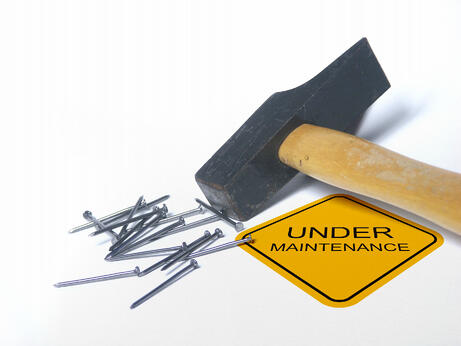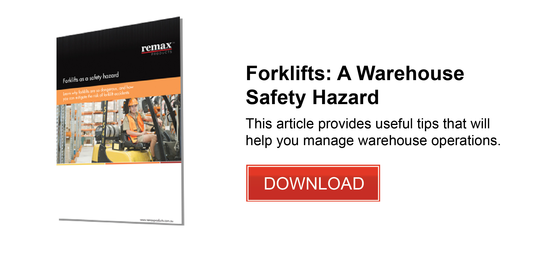Forklift Accidents: Reducing Damage to Product & Equipment

Four steps to avoiding costly damage to products and equipment by forklifts
We previously discussed how forklifts can endanger the lives of pedestrians. Now, we'll move onto how forklifts can inflict serious damage on the surrounding product and even the warehouse itself.
Below are some examples of excessive maintenance costs incurred by forklift accidents, as well as four steps to avoiding such situations.
Here are a few recent examples of the damage that forklifts can cause to their surrounds through accident and misuse:
- A Heathrow forklift driver caused over a £1 million of damage crashing into a plane he was servicing simply by forgetting the size of the vehicle he was driving. When he tried to cross under a plane, he crashed into it nearly severing the fuel line, forcing the passengers and crew to evacuate.
(Source: DailyMail) - A driver in America caused $250,000 of damage when he split a water hose valve while placing a 4 ton roll of metal in a storage rack.
(Source: EHS News) - Another recent instance involves an offender who used a forklift to cause severe damage in the Porthaul factory in Kalina Court, including smashing through a door, before making a run for it.
(Source: Standard)
These are just a few examples of the damage that can be caused on your site by forklifts. Stories that are less serious don’t often make the headlines, but there are no doubt thousands of stories of small accidents with broken product, walls, doors and equipment.
So how can you protect yourself against big and small accidents in your warehouse?
1. Consider Your Warehouse Design
Good warehouse design can go a long way in preventing accidents. Human error is not as easily controlled as making sure the warehouse is designed properly so as to give those working in it the safest and most efficient work space possible.
Here are some features of poor warehouse design which can cause accidents and should be avoided.
Avoid narrow aisles, crowded and cluttered aisles, and obstructions at intersections and doors.
Space and cleanliness are the two major features of keeping a warehouse accident free.
While decreased aisle width might mean more storage space it also means less maneuverability for your staff and their equipment. This increases the chance of accidents and also increases their severity because everything is closer together, meaning more collateral damage.
Instead use wider aisles and a clean work space. Also remember to monitor the change of surfaces, particularly on ramps, where traction and control become even more vital. This is crucial in reducing risk, hazards and accidents in the warehouse.
Avoid a high volume of traffic in the work area, and working in the general vicinity of the forklift.
This reduces space, making driving more difficult and accidents more likely.
Avoid noise, odours, toxic gases, dust and poor lighting.
Although these are probably more likely to occur in extreme situations or as a result of other accidents, contingency plans for these problems should always be available as should the right equipment to deal with the situation.
2. Consider Mechanical Conditions and Faults That Can Cause Accidents
There are many mechanical conditions or design features that can cause an increase in accident occurrence. These include
- Malfunction of forklift brakes, steering, or clutch
- Leaks in any machinery hydraulic systems or transmissions
- Safety devices being inadequate, under serviced or malfunctioning
Many of these occurrences may not be immediately obvious as a hazard but leakages and emissions from forklifts can be hazardous for other equipment and people in the workplace.
It is important to make sure each piece of machinery fits well into your warehouse environment. Each vehicle has different blind spots and controls meaning different situations can be more and less hazardous for different vehicles.
It pays to have your equipment serviced regularly and well maintained to avoid accidents occurring. Regular checks and good training will go a long way in greatly reducing workplace accidents.
3. Safety Equipment onsite to keep Employees Safe
Although ensuring that the site is left unharmed, the ultimate goal is keeping people safe, as well as dangerous equipment. There is a large range of equipment available to assist with ensuring that staff are safe from forklift incidents. Some of the more dangerous areas of site can include doorways, especially where multiple vehicles may be passing through or visibility through the doorway may be limited.
The Movidor Rapid Door has been designed with forklift users mind, ensuring that LED integrated Rapid Door traffic lights are installed on doors means that both the forklift driver and those on the other side of the doorway are aware of traffic passing through / waiting on the other side or totally clear of traffic and safe to pass though.
4. Use Equipment That Adapts Well to Accidents and Collisions
Should the above measures not be enough and an accident does occur it is important to have equipment that adapts well to the situation. With the right equipment, damage and time lost from any accidents can be greatly reduced.
Guard rails and bollards can provide protection for walls, doors and other important features. As mentioned last week rapid roller doors like Movidor are ideal for this - they are not only quick but can be self-repairing. Having doors that will function under severe stress or collision can make your warehouse safer and more efficient.
For more information on this topic, download our complimentary article:





